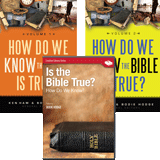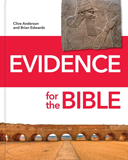
Fragments of Truth Film Review
Can we really know the original message of the New Testament? Skeptics frequently claim that our modern Bibles are the result of numerous copies and translations, so the original message is unknowable having been lost through the various stages of transmission. They often say the original message is corrupted much like the original message is changed in the childhood game of telephone (or Chinese whispers). But is this popular objection to the reliability of Scripture an accurate portrayal of the actual history of the Bible’s transmission?
A powerful new documentary refutes this objection and other similar skeptical claims while highlighting the authenticity of the New Testament. Fragments of Truth, produced by Faithlife Films and scheduled for a one-night theater release on April 24, features more than a dozen scholars and experts who set the record straight concerning the reliability of the New Testament texts.
Integrity of the Manuscripts
At the Ark Encounter, our “bean video” introduces guests to the manuscript evidence for the New Testament by comparing it to the textual evidence for other ancient works. This short clip demonstrates the New Testament’s overwhelming superiority in the number of manuscripts compared to other writings, and an extra scene available here briefly addresses the textual variants (differences), but it does not address many related questions raised by critics and skeptics. How accurate are the manuscripts? How can we be confident of the dates and authors ascribed to them? What about other religious writings not included in the “canon” of Scripture (the collection of writings recognized by God’s people as the only inspired, inerrant words of God)?
Fragments of Truth tackles these questions and many others as it takes viewers on a journey to the libraries and museums where some of the oldest fragments and manuscripts are housed today. This short 75-minute film helps viewers understand how the books of the New Testament were written, copied, distributed, and translated while dismantling modern skeptical arguments promoted by scholarly critics like Bart Ehrman. One section even addresses some of the patently false and ridiculous assertions about Constantine, the canon, and the Council of Nicaea made by conspiracy authors like Dan Brown and repeated countless times online and on college campuses.
A Neglected Apologetic
For many decades, conservative Christians have taught young people that the Bible is the inerrant and infallible Word of God—and it is. However, we have often failed to carefully nuance this teaching by highlighting the fact that the doctrine of inerrancy applies to the original autographs of Scripture, and it only applies to the copies insofar as they accurately represent the originals. We regularly shy away from the discipline known as textual criticism. Perhaps it is because it sounds like someone is criticizing the Bible or because we conflate this legitimate scientific pursuit with the illegitimate, biased, and anti-God teachings of 19th century German “higher criticism,” another idea debunked in the film.
This oversight has produced generations of young people whose confidence in Scripture is easily shattered by the first person who points out some of the differences in the copies. Many of these differences can be seen in the marginal notes or footnotes of most study Bibles. Opportunistic skeptics like Ehrman speak about the tens of thousands, or even hundreds of thousands of variants between the New Testament manuscripts. In fact, Ehrman points out that there are even more differences among the manuscripts than there are words in the New Testament. How can anyone possibly believe it to be the Word of God?
Fragments of Truth shows viewers the truth about textual criticism and demonstrates how this area of research actually confirms our belief in the inerrancy of Scripture.
Fragments of Truth shows viewers the truth about textual criticism and demonstrates how this area of research actually confirms our belief in the inerrancy of Scripture. In fact, the many variants touted by skeptics lend tremendous support to the authenticity of the biblical text since only a tiny fraction (just one-fifth of one percent) are meaningful and viable, as leading textual scholar Dr. Dan Wallace explains in the film. And 70 percent of that tiny fraction are simply spelling errors. In these cases, because we know what the differences are, where they are found, and often when they were introduced, we can be highly confident of recognizing the original wording in nearly every single instance. And for those few differences that might still be questionable, even Bart Ehrman himself has stated that they do not impact any Christian doctrine.
A Unique Opportunity
One of the most fascinating aspects of the film is the opportunity for viewers to see fragments from texts written nearly 2,000 years ago. Seeing the Scripture written on ancient papyrus and hearing the stories of their preservation and discovery is sure to confirm your trust in the Word of God. Dr. Craig Evans traveled across Europe to examine these precious artifacts stored in libraries, bringing to life the pieces that show how God has faithfully revealed himself to us through the millennia.
Viewers are also treated to some introductory teaching about ancient writing practices. We learn about the difference between papyrus and parchment. We also learn about the craft of the scribe and how experts in ancient handwriting (paleographers) assign dates to various texts. Another interesting fact about the early church is that they used codices (an early form of books) for compiling the Scriptures while nearly everyone else relied almost exclusively on scrolls. This fact put the church on the cutting edge of technology at the time and assisted in the widespread use and preservation of Scripture.
The film also discusses an important recent discovery about the lifespan of ancient papyri.
Speaking of the preservation of the text, the film also discusses an important recent discovery about the lifespan of ancient papyri. For centuries, it was often assumed that these writings only survived for a couple of decades or so and needed to be copied before they were no longer usable. This assumption has been overturned, and we now know that in many cases ancient papyri could have been used for at least 150 years, and possibly for as many as 300 or 400 years. This means that the original manuscripts written by biblical authors were likely still in existence when our earliest complete copies were made. This fact goes a long way in dismantling the common objection that compares the Bible’s transmission to the telephone game.
Narrated by John Rhys-Davies (Lord of the Rings and Indiana Jones) and hosted by Dr. Craig Evans, the information contained in this documentary is crucial for Christians to understand in these increasingly skeptical times. The information presented in this film should be taught to every Christian so that we have a better understanding of the way God has preserved his Word for us today. Don’t miss the opportunity to see this important film on April 24 and gain a better understanding and appreciation of the text Christians hold so dear.
Recommended Resources

Answers in Genesis is an apologetics ministry, dedicated to helping Christians defend their faith and proclaim the good news of Jesus Christ.
- Customer Service 800.778.3390
- © 2024 Answers in Genesis





